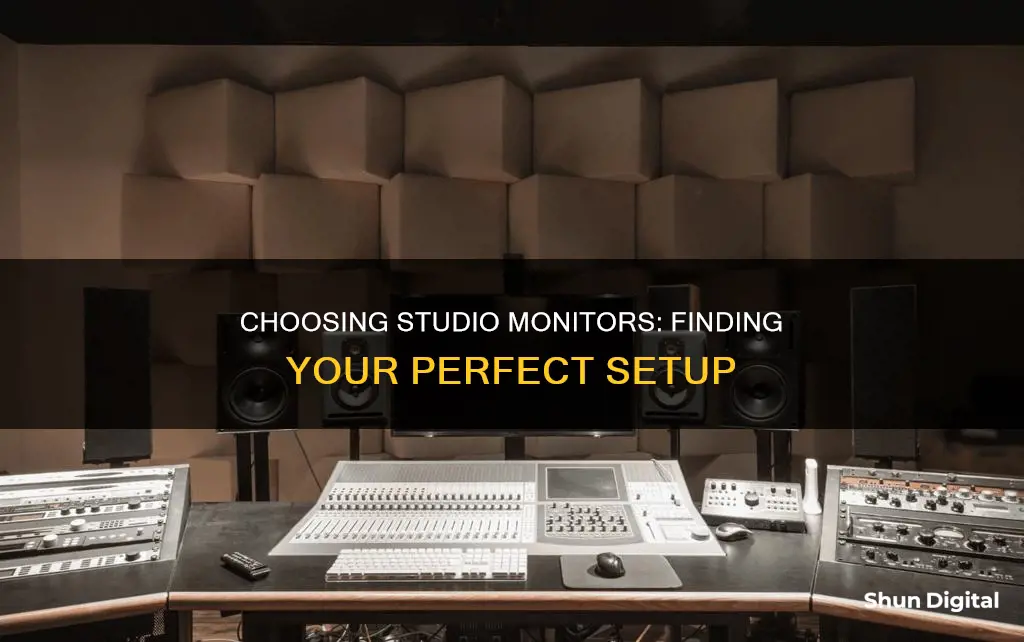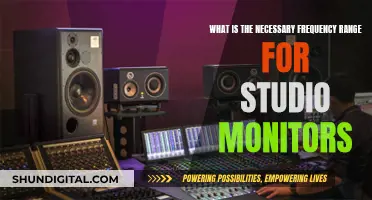
Studio monitors are an essential component of any recording or mixing space, and setting them up correctly is crucial to ensure your audio productions sound their best. The placement of your monitors in the room and your listening position are key factors in achieving an accurate frequency response and a solid stereo image. The goal is to create an environment where a natural balance of sounds can exist, unaffected by room acoustics. One of the biggest obstacles to this is a condition known as room modes, which occur when a room's dimensions match the length of a sound wave or a multiple of its half-wavelength. This results in standing waves that distort the overall balance of the room.
To minimise the impact of room modes, it's recommended to form an equilateral triangle with your monitors and your head, with the distance between the left and right speakers and your head being equal. This ensures a natural stereo sweet spot that allows for some movement without sacrificing the stereo image. Additionally, the monitors should be positioned slightly above ear level when seated and angled directly towards your head to minimise high-frequency reflections off the sidewalls. If your monitors have rear ports, it's important to keep them away from the wall to reduce low-frequency reflections.
Another factor to consider is the type of monitors you choose. Active monitors with built-in amplifiers offer simplicity and ease of use, while passive monitors provide more flexibility by allowing you to choose an external amplifier. The size of the monitors and the room you have also play a role in your setup. For home studios, 5-inch monitors are often a good choice, but larger rooms may require bigger monitors to fill the space adequately. It's also worth noting that the wattage of your monitors will determine their ability to deliver sound levels without distortion, so choose accordingly based on your room size.
Lastly, don't forget the importance of acoustic treatment. Adding bass traps behind your monitors and acoustic panels at initial reflection points can help minimise reflections and improve the accuracy of your sound. By following these guidelines and making adjustments based on your specific room and needs, you can optimise your studio monitor setup to achieve the best results.
| Characteristics | Values |
|---|---|
| Speaker placement | Should form an equilateral triangle with the listener's head |
| Speaker height | Should be at the same height as the listener's ears |
| Speaker angle | Should be angled towards the listener's ears |
| Speaker distance | Should be placed around 8-12 inches away from walls and corners |
| Speaker size | Should align with room size and music style |
| Wattage | Determines the monitor's ability to deliver adequate sound levels without distortion |
| Budget | Beginners: $200-$400; Intermediate: $400-$1,000; Professionals: upwards of $1,000 per monitor |
What You'll Learn

Speaker placement and geometry
The placement of your studio monitors in the room and relative to your listening position is crucial in achieving an accurate frequency response and a solid stereo image. The ideal setup is to have your listening position and the two monitors form an equilateral triangle, with the monitors pointing directly at your head or slightly behind it. This ensures that you are in the "sweet spot" of the stereo image, allowing for a natural listening experience and some flexibility in your head movement.
To set up this triangle, use a tape measure, a piece of string, or even a guitar cable to ensure that the distance between the left and right speakers and the distance from each speaker to the back of your head are equal. The recommended distance between the monitors and your head is about 3 feet, which also helps minimise the effect of mid- and high-frequency room reflections. Additionally, the tweeters of the monitors should be at the same height as your ears when seated, typically about 47-55 inches (120-140 cm) from the floor. If you need to clear the top of your computer monitor, you can place the speakers slightly higher and tilt them down towards your listening position. However, be careful when tilting speakers as they can topple over.
When positioning your studio monitors, it is important to consider the distance from the front and side walls. Try to place the monitors close to the front wall (almost against it) or at least 43 inches (110 cm) away. If the speakers are placed near the wall, their bass response will be exaggerated, and many monitors provide onboard EQ settings such as whole-space (flat EQ for placement away from walls), half-space (bass reduction for placement near the front wall), and quarter-space (bass reduction for placement near front corners). Keeping symmetry in mind, ensure that the left and right speakers are equidistant from their respective side walls.
If your speakers have rear ports, maintain a distance from the wall that is at least equal to the diameter of the port (usually about 5-10 cm). Speakers placed too close to the front wall (within 15-44 inches or 38-110 cm) can create uneven bass response due to low-frequency reflections. Similarly, a distance of at least 44 inches from the nearest side wall is recommended. If your speakers must be placed near a side wall or corner, use the quarter-space EQ setting to mitigate any extra bass build-up, and consider adding acoustic treatment to the front and side walls.
Another important aspect of speaker placement is the angle between the speakers. The ideal angle for stereo monitors is approximately 60° (between the speakers) or 30° between each speaker and the "sweet spot". This setup helps maintain an optimal stereo image and minimises the impact of room reflections.
To summarise, when setting up your studio monitors, strive for an equilateral triangle between the monitors and your listening position, with the monitors slightly angled towards your head. Ensure proper distances from the front and side walls, and if possible, use EQ settings to compensate for any bass build-up caused by wall proximity.
Connecting Pansonic SB Subwoofer to Studio Monitors: A Step-by-Step Guide
You may want to see also

Monitor placement
The placement of your studio monitors is crucial to achieving an accurate frequency response and a solid stereo image. The ideal setup is to form an equilateral triangle, with your head at the triangle's apex, and the two monitors at the other two corners. This ensures that the distance between the left and right speakers and the distance from each speaker to the back of your head are equal. This setup provides a good compromise between too-wide and too-narrow stereo imaging.
It is also important to angle the monitors directly towards your head, or slightly behind it. High frequencies are more directional than lower frequencies, so you may not hear the high frequencies accurately if the tweeters are not pointed directly at you. The ideal height for the tweeters is at the same level as your ears when seated, typically about 47-55 inches (120-140 cm) from the floor. If you need to clear the top of your computer monitor, you can place the speakers slightly higher and tilt them down towards you, but be careful to avoid the speakers toppling over.
Regarding the distance from the wall, it is recommended to place your monitors either almost against the front wall or at least 43 inches (110 cm) away. If placed close to the wall, the bass response will be exaggerated by up to 6dB due to the boundary effect. Many monitors provide onboard EQ settings to compensate for this, such as "whole-space" (flat EQ for placement away from walls), "half-space" (bass reduction for placement near the wall), and "quarter-space" (increased bass reduction for placement near corners).
To minimize the impact of room modes and standing waves, vary the distances between your monitors and each wall. Here are some tips:
- Position the monitors against the longest wall to minimize side reflections.
- Ensure that the height of the monitors is either slightly above or below the midpoint between the floor and ceiling.
- Compare the distances between the monitors and the sidewalls, and adjust if necessary to avoid matching the distances from the front and rear walls.
- Create space between the monitors and the rear wall to reduce the impact of rear reflections. A distance of 1-2 feet is recommended for most rooms.
In addition to the monitor placement, it is also important to consider the placement of your listening position or "sweet spot". Center your chair between the sidewalls to maintain a symmetrical stereo image. Set the chair height so that your head is not halfway between the ceiling and the floor. Adjust the chair and desk position to avoid being halfway between the front and back walls. Compare and vary the distances on all three dimensions to minimize the impact of standing waves.
To further optimize the sound, consider adding acoustic treatment to your setup. Here are some suggestions:
- Add bass traps behind each monitor to minimize reflected bass frequencies from the rear wall.
- Add acoustic panels or other absorption materials at initial reflection points: two above your head, one on the left wall, and one on the right wall.
- Add diffusion to the rear wall to scatter the sound energy and reduce the creation of standing waves.
By following these guidelines for monitor placement and acoustic treatment, you can achieve a more accurate and balanced sound in your studio.
Is Your LCD Monitor Damaged? Here's How to Tell
You may want to see also

Room modes
When two or more room dimensions are equal, such as in a standard 10x10 bedroom, the problem is amplified because there are twice as many standing waves at the same group of frequencies, creating even bigger spikes in the frequency spectrum. This is why people say that cubed rooms are the worst for room modes.
In a bedroom-sized studio, problems with standing waves typically occur at frequencies below 300 Hz. This is because at higher frequencies, sound waves are shorter, and at lower frequencies, they are longer. Therefore, when the waves and the room's dimensions are similar in length, there are more problems.
To minimize the effects of standing waves, it is better to spread those waves across multiple frequencies rather than having many waves at the same frequency. This can be achieved by varying the distances between the monitors and each wall. Here are some tips to achieve this:
- Position monitors against the longest wall: In terms of the width of the room, it is challenging to vary the distances from the sidewalls while maintaining a symmetrical stereo image. Therefore, the best solution is to set up the monitors against the longest wall to minimize problems from side reflections.
- Vary the distances: Ensure that the height of the monitors is either slightly above or below the midpoint between the floor and ceiling. Measure the distance between the monitors and the sidewalls, and adjust them so they are neither the same nor an exact multiple of the previous two distances.
- Create space between the monitors and the rear wall: Since bass frequencies project outward in all directions, much of that sound travels backward and reflects off the rear wall. To solve this problem, pro studios often build their monitors directly into the wall, eliminating all rear reflections. For home studios, the next best option is to maximize the separation between the wall and the monitors, ideally between 1-2 feet.
- Find a good head position: Center your chair between the sidewalls to maintain a symmetrical stereo image. Set the chair height so your head is not halfway between the ceiling and the floor. Adjust the chair/desk position so it is not halfway between the front and back walls. Measure and compare the distances on all three dimensions to ensure they are neither the same nor exact multiples of each other.
In addition to monitor placement, acoustic treatment can also help minimize standing waves. Here are some tips for acoustic treatment:
- Add bass traps behind monitors: Place bass traps directly behind each monitor to minimize reflected bass frequencies from the rear wall.
- Add absorption at initial reflection points: Identify the four key locations that cause the majority of problems with reflected sound from the monitors (two above your head, one on the left wall, and one on the right wall). Cover these spots with acoustic panels.
- Add diffusion to the rear wall: The wall behind your head can create more standing waves than any other surface in the room if it is flat. Covering it with diffusers will scatter the energy before it can cause problems.
Understanding Aspect Control and Overscan on ASUS Monitors
You may want to see also

Speaker isolation pads
There are a variety of speaker isolation pads available on Amazon, suitable for different speaker sizes and offering various features. For instance, the Liquid Stands Studio Monitor Sound Isolation Pads aresection text angled speaker risers that prevent vibrations and fit both the floor and desktop. The Sound Addicted Studio Monitor Isolation Pads are designed for 5-inch monitors and use high-density acoustic foam to reduce vibrations. The JBER 2 Pack Acoustic Isolation Pads are suitable for 3-8 inch speakers and also help improve sound by preventing vibrations. The TRUE NORTH Studio Monitor Isolation Pads are designed for 3-4.5 inch speakers and promise to deliver sound isolation and improved speaker foam performance.
Monitoring Applications: Performance Issue Prevention Strategies
You may want to see also

Acoustic treatment
- Speaker Placement: Place your monitors symmetrically in the room, forming an equilateral triangle with your listening position. Avoid placing them too close to the corners or walls, and follow the manufacturer's recommendations for spacing from walls. Ensure the speakers are at ear height and angled towards your head.
- Absorbing Reflections: Address reflections from hard surfaces such as walls, ceilings, and desks. Use acoustic panels or foam to absorb mid-range and high frequencies. For low-frequency absorption, consider bass traps, especially in room corners.
- Speaker Isolation: Use speaker isolation pads or stands to decouple the speakers from the surface they're resting on, reducing vibrations and improving sound quality.
- High-Frequency Reflections: High frequencies are more directional, so ensure your monitors are pointed directly at your head to minimise high-frequency reflections off side walls.
- Rear Wall Placement: Try to place monitors close to the front wall or at least 43 inches (110 cm) away to avoid exaggerated bass response. Many monitors have onboard EQ settings to compensate for different placements.
- Speaker Ports: If your speakers have rear ports, maintain a distance from the wall that's at least equal to the port diameter (typically 5-10 cm).
- Side Wall Placement: Place speakers at least 44 inches (110 cm) away from side walls to prevent uneven bass response.
- Acoustic Foam: Understand the limitations of acoustic foam; it's most effective for high frequencies and becomes less effective at lower frequencies. Thicker foam or spacing it away from the wall can improve low-frequency absorption.
- Diffusion: Use diffusers to break up high-frequency reflections and make them less disruptive. Commercial diffusers are available, or you can use shelves filled with books and gear.
- Bass Absorption: Bass absorbers or bass traps can help reduce bass peaks and troughs. Ready-made bass traps are available, or you can create DIY solutions using rockwool or other materials.
- Room Modes and Low End: Address room modes or resonances caused by the room's dimensions, which can result in uneven bass response. Consider using bass traps or other bass absorption techniques.
- Isolation and Sound Leakage: Reduce sound leakage by sealing gaps around doors and windows, and consider double-tacking walls and ceilings with an additional layer of plasterboard to improve bass response and reduce sound transmission.
Choosing the Right Monitor Size for Programming Work
You may want to see also
Frequently asked questions
The ideal setup for studio monitors is to have them positioned symmetrically and at an equal distance from the listener, forming an equilateral triangle. The height of the monitors should be at ear level when seated, and they should be angled at around 45 degrees towards the listener. It is also recommended to have some space between the monitors and the walls to reduce the impact of reflections.
When choosing studio monitors, it is important to consider the size of the room, the desired level of accuracy, and the price. Larger rooms typically require larger monitors with more power to fill the space. If accuracy is a priority, look for monitors with a flat frequency response and minimal distortion. In terms of price, more expensive monitors may offer improved consistency, robustness, and quality control, but there are also exceptional options at lower price points.
Some common mistakes to avoid when setting up studio monitors include placing them too close to walls, which can affect the bass response; positioning them at poor angles, which can impact stereo panning decisions; and excessive levels, which can cause ear fatigue and affect mixing decisions. It is also important to avoid adding too much bass or treble to the monitors' built-in EQ settings, as this can lead to inaccurate mixing decisions.







